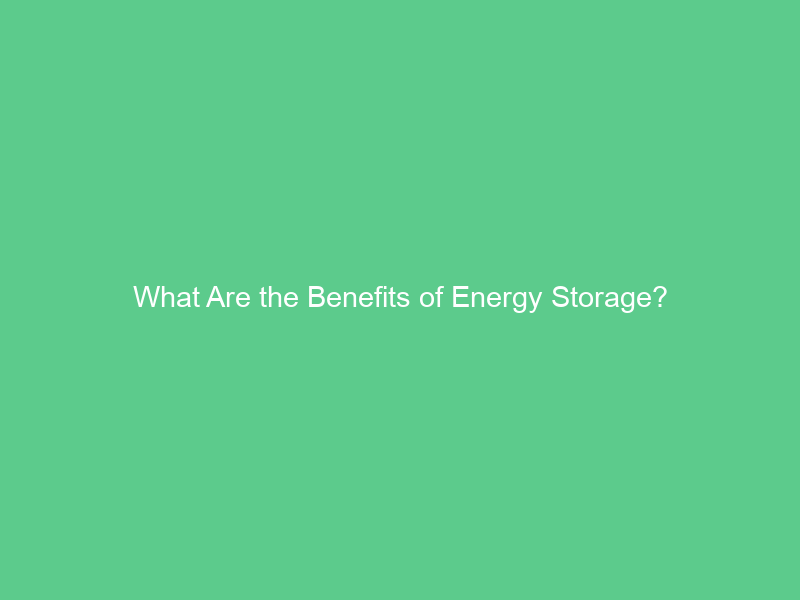Energy storage allows renewable power sources like solar or wind to continue flowing into the grid even when sunlight or breeze are unavailable, helping ensure their output matches up with demand for power.
Battery storage is one form of energy storage that can be implemented at scale, while other options include pumped hydro, compressed air storage and superconducting magnetics.
Energy Storage is a Key to Renewable Energy Expansion
Energy storage can expand renewable energy’s reach. By capturing electricity produced at one place and time and using it later on a different location or time of the year, energy storage allows renewables to become more widely accessible while decreasing peak energy demand loads and carbon emissions.
Energy storage technologies range from capacitors that store 1 Watt for seconds up to large battery storage systems capable of powering entire electric grids. Other forms of energy storage are pumped hydro storage, flywheels and compressed-air energy storage systems as well as hydrogen and thermal ice.
Gatti predicts rapid expansion in BESS installations worldwide due to falling costs and innovative technologies like lead-acid, redox flow and molten salt systems.
It Can Help Customers Avoid Peak Pricing
Energy storage makes renewable sources like wind and solar more practical by decreasing their fluctuation, improving grid efficiency, and helping to lower transmission costs.
Businesses that invest in long-duration energy storage systems can utilize it to reduce demand charges, provide critical backup power for production operations and take part in demand response programs without interrupting production or operations. They may even leverage it as an additional revenue stream by bidding or trading available capacity into merchant market participation programs or trading it against ancillary services.
Facilities often need investment and education in order to fully comprehend the potential advantages of energy storage. There are various ownership and financing arrangements, such as direct purchase, third-party management agreements, leasing options, federal investment tax credits and tax credit monetization services available for energy storage systems. A reliable energy storage technology partner can assist organizations with selecting an ideal ownership structure based on their unique circumstances and internal capabilities as well as selecting an optimal system design based on local utility prices, rates, incentives available and financial goals.
It Can Help Rural Communities Avoid Blackouts
Energy storage systems can increase grid reliability and resilience by storing excess electricity generated from renewable sources and making it available during times of high demand. They also help lower electric bills as they remove the need to purchase expensive energy from the grid during these peak demand times, thus saving costs associated with grid energy purchases during such times.
Many rural communities that reside far from the grid can be vulnerable to blackouts and higher energy costs, making them susceptible to blackouts and higher energy bills. Battery energy storage solutions may help mitigate these concerns by decreasing how much electricity needs to be bought from the grid during peak demand times.
Rural businesses can also take advantage of energy storage systems to address peak demand and save on electricity rates, particularly energy-intensive industries like mines and factories that see their electric bills spike during peak times. Battery storage systems offer them the chance to offset these high rates while making the most of renewable investments, while also storing excess energy during periods of lower demand and using it later for maximum energy independence and cost savings.
It Can Help Communities that Are Farther From the Grid
At the local-grid level, battery storage provides an effective means of maintaining reliable electricity during disruptions. This work behind-the-scenes can prevent outages and reduce voltage fluctuations that damage equipment while integrating more renewable capacity into the grid while keeping local grid stability. At grid scale utility owned community energy storage (CES) systems can offer services like peak demand shaving, islanding support, load leveling at substations, power factor correction as well as providing other ancillary services.
At the residential-grid level, aggregated rooftop solar with battery backup allows communities to participate in utilities’ demand-response programs and take advantage of federal investment tax credits, monetization services and other ownership options that take advantage of grid-scale energy storage’s diverse benefits. Utility-scale storage can help meet high electricity demands in densely-populated cities while preventing price spikes and outages, decreasing pollution emissions caused by peak power plants while meeting electricity demands more reliably – this reduces price spikes while meeting outages quickly as well as meeting high electricity demands quickly while meeting high electricity demands that requires costly peak power plants with pollution emissions emissions reducing price spikes and outages as well as pollution emitters that emit peak power plants can reduce pollution emissions significantly and emissions associated with peak power plants.

